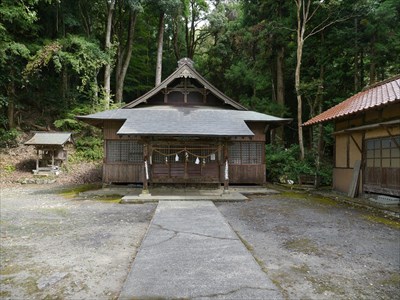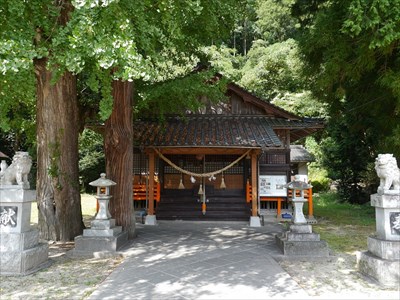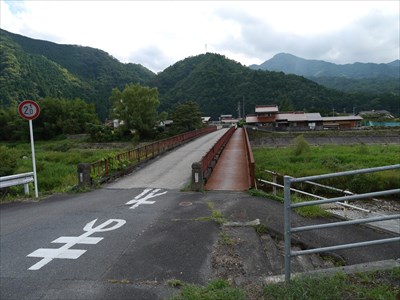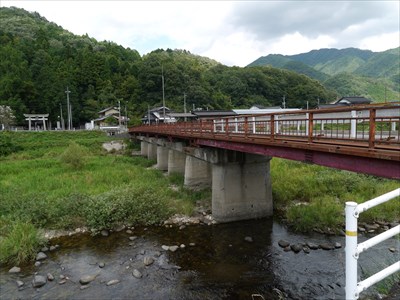| Home>Myth>Article |
The Yakuro Deer as evil deer
The following text is a slightly modified machine translation and may have some unnatural parts.
==Introduction==
There is a evil deer legend called Yakuro deer (Yatsuguro-no-Shika, Yakuro-Shika) in Yoshika-town, Shimane Prefecture. It is also the land name tale of the Town of Yoshika (from good deer). It seems that a legend of almost the same content is left to the Futashika shrines in Iwakuni city, which spaced the mountains.

Kushika Shrine at Kakinoki village

Kushika Shrine at Nanokaichi
Shika means deer.
The Legend of Yakuro deer is introduced in the title "Deer's Legend and Deer Daimyojin" in Chapter 2 seven sections of "Muikaichi town History Vol. 1". It seems that there are some variations, but I will introduce what was recorded in the geographic magazine written during the Edo period called "Yoshika-Ki".
==Synopsis==
In the era of the 42th Emperor Monmu (reign: 697 to 707), the damage caused by a evil deer was rampant in Chikushi country in Kyushu.
The deer is eight legs and its antlers are separated eight or more. The length of the red hair is one shaku (30cm). The eyes shine like a mirror. Running between heaven and land, deer beat birds and beasts, and robbed people. The name is a Yatsuguro deer. The common people were scared of deer and stopped agricultural work. Immediately hearing the emperor, the Emperor declared the Tamezane Fujiwara and Tamemasa Fujiwara to defeat the beast. Tamezane started with the northern Samurai Taro Eguma. And he tracked evil deer deep in the mountains.
Evil deer went from Kokura to a Botyo region. And deer passed by Shikano-manor Kabe-county, and came to Ooka mountain, Kawachi, Yoshika-manor, Kanoashi-county, deep in Iwami region. And deer stood. And the deer was sitting at Mitsuiwa rock in the west of the Ooka mountain as if the snake coils on itself.
Taro Eguma approached to the Kingoro rock without hesitation, and he shot the poison arrow. Then he hit a evil deer. Then the evil deer turned to the flying dragon immediately. And the deer aimed at Taro and was approaching the Kingoro rock. Taro Eguma shotted evil deer with the next arrow.
This deer was a central beast of the world. Death of deer Immediately caused clouds and mist in four ways. Clouds and fog covered the sky. The heavens and the earth shaked. Taro Eguma fell by this bad work and died.
So the people complained of evil deer damage to Lord Fujiwara of the Secretary Yamaguchi, Botyo region. And the deer's skeleton was thrown out. In particular, both feet were headed for the day. Lord Fujiwara checked the state of evil deer. And Lord Fujiwara recorded the work of the soldiers and filled this evil deer in the tomb. He immediately dropped the antlers divided into eight and sealed the skeleton in this rice field and balk.
People of the future enshrined this deer tomb as a seven lucky gods. It is in Nukumai. In addition, the place where the evil deer is dismantled is called a Karada-Kuzushi (body dismantling). In addition, Lord Fujiwara made the artist draw a evil deer's figure. And he wrote the origin. And the remaining ink was poured into this waterfall. It is called Sumi-nagare (poured ink). The any water of waterfall is black. In addition, the people of the village dismantled the evil deer under the Yuzu citron tree. Therefore, they say that a citron tree does not occur here in the future.
The people of the village enshrined Taro Eguma as god and celebrated as Kojin Myojin. They also enshrined the deer spirit as god. When the soul was worshiped as god, it worked miracles and celebrated a evil deer and named a Yoshika (good deer) and became the manor name.
It is said that deer have been regarded as sacred beasts since ancient times (although they are also vermin, of course), and the legend of evil deer that is exterminated by royal command stands out.
This legend is also introduced in Kadokawa Shoten "Legend of Izumo / Iwami Japanese Legend 48" (121-122P). Here, the Yakuro deer is considered to be the incarnation of the Yamata no Orochi. The setting of the era of Emperor Monmu is the same, but Morosato Fujiwara and Saburo Eguma are the ones who defeat the deer.
In addition, Mt. Ooka is said to be Mt. Ooka in Kakinoki Village or Mt. Ooka in Tachido, Muikaichi village.
==Relationship with the legend of Yamata no Orochi==
Looking at the topography of the Yoshika region, it seems that the Yoshika River and its tributaries are divided into eight parts. Therefore, in the old days, floods and vermin hindered cultivation. In that respect, "Legend of Izumo and Iwami, Legend of Japan 48" points out that it has a structure similar to the legend of Yamata no Orochi.
The legend of Yairoishi in Onan town, Ochi county also has an interpretation that the large snake is a descendant of the Yamata no Orochi, and it can be said that it has a similar aspect.
==Kagura==
"Nukutsuki Kagura Shimane Prefectural Ancient Culture Center Research Report 11" contains an oral script of the creative Kagura "Yaguro Jika" (P. 94-95). It seems that deer is a Oni demon in this performance, but deer still calls himself the Yamata no Orochi clan. In addition, Shiro Nagano from Iwami Province will appear.
==Mr. Mizukami's treatise==
Isao Mizukami "Following the original image of the giant deer" Isasa-Ou "in Harima region -Consideration of tradition of the" evil deer "in the chugoku mountains-" I knew this legend in two papers, "Consideration of legend of "Jinrin "and" Ushioni "-Legend of Silla's Invasion and Tradition of Youkai in Setouchi region-".
The main consideration of Mizukami's paper is the legend of the evil deer called "Isasa-Ou" in Harima region. The Mizukami treatise of "Jinrin" is structured to proceed from the association of the etymology of the character "塵 (dust)" (smoke made by deer) to the consideration of the Jinrin, with the legend of Yatsugoro deer in front.
==Similar story: Manga Nippon Mukashi Banashi==
Although it is not a legend of the Yatsuguro deer itself, a folk tale of Kyushu is animated under the title of "Kushiki Iro no Oshika (The big strange-colored deer)". Director / Drawing: Shinichi Tsuji, Literature: Isao Okishima, Art: Kazunori Shimomichi. The source is credited as "from Shigetaka Hiejima (published by Mirai-sha)", which seems to be the story of Miyazaki Prefecture.
A mountain country in Kyushu. The wealthy person's daughter was reputed to be beautiful. A lot of men come to see his daughter at a glance. But at some point his daughter disappeared. A young man learns that his daughter is lying down due to a serious illness. Shortly thereafter, the young man was washed away by a river flooded by heavy rain. A strange-colored deer saved the young man when he fell into the waterfall. The young man promises the deer that this will never be revealed to anyone. However, a young man who knows that drinking the blood of a living strange-colored deer will cure his daughter's illness informs the wealthy person of the deer's whereabouts. The wealthy person goes out to shoot the deer. But who taught here? The young man confesses that he has informed him of the deer's question. The wealthy person turned back without shooting the deer. After that, his daughter's illness got better, but the young man disappeared because he was ashamed of himself.
==Digression==
* Kibedani, Kakinoki village, Yoshika town, Kanoashi county / Kushika Shrine National route 187, Tsuwano Road. There is a road to Kibetani village to the east near Kibetani Bridge, and if you follow the road, you will find a shrine.
* Nanokaichi, Yoshika town, Kanoashi county / Kushika Shrine The shrine faces National route 187 and Tsuwano Road. Near the Nukutsuki Bridge. At the time of the visit, I once entered the center of Nanokaichi and parked the car on the side of the road near Nanokaichi Elementary School.


Nukutsuki bridge at Nanokaichi
It is a legend that represents Kanoashi county, and I didn't know it carelessly until I became an adult. After all, I bought a secondhand book of "Legend of Izumo / Iwami".
The eight-legged figure may be reminiscent of the Norse mythological horse Sleipnir.
I was associated with an episode of Osamu Tezuka's manga "Blackjack." He transplanted the stag's brain into the abdomen, but the cyborged deer's brain became abnormally developed and ferocious, and the stagr was shot dead. Probably based on the "The Yearling".
I've lived in the Harima region of Hyogo prefecture for several years, but I haven't read the legends. It made me feel that it was also necessary to investigate the history and legends of the area where I live.
==References==
- * 『出雲・石見の伝説 日本の伝説48』(酒井董美, 萩坂昇, 角川書店, 1980)pp.121-122
- * 『六日市町史 第1巻』(六日市町/編, 六日市町教育委員会, 1981)pp.324-328
- * 『抜月神楽 島根県古代文化センター調査研究報告書 11』(島根県古代文化センター/編, 島根県古代文化センター, 2002)pp.94-95
- * 水上勲『播磨の巨鹿「伊佐々王」の原像を追って―中国山地の「悪鹿」伝承考―』『帝塚山大学人文科学部紀要』第十六号(帝塚山大学人文科学部, 2004)pp.31-45
- * 水上勲「《塵輪》《牛鬼》伝説考―「新羅」来襲伝説と瀬戸内の妖怪伝承―」「帝塚山大学人文科学部紀要」第十八号(帝塚山大学人文科学, 2005)pp.19-37